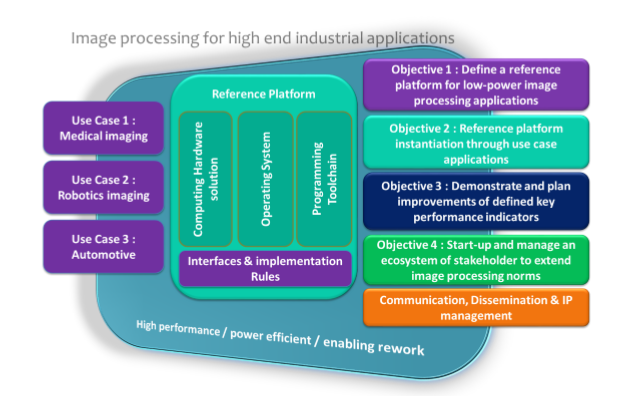Many industrial domains rely on vision-based applications which require to comply with severe performance and embedded requirements. These domains are best represented by medical imaging (3D reconstruction), automotive advanced systems (pedestrian detection, blind spot detection, or lane departure warning system) and Unmanned Aerial Vehicles (observation in hazardous environment).
Such vision-based applications are based on two main building blocks that are image processing and image display. Sensors are then increasingly numerous, while having to cope with a simultaneous growth in smartness and data rate. This brings image processing to a complexity level never met so far. Moreover, this technological challenge is also strongly resource bounded both in terms of with autonomy and energy consumption.
Needs from end user (e.g. patient in medical domain of applications), customer, and prospective business and technological innovation (like Internet of things) drive such a growing trend. Thus, many high quality industrial domains, are looking for high-end vision based systems that cannot simply use low requirements consumer electronics. Tulipp will develop a reference platform that defines implementation rules and interfaces to tackle power consumption issues while delivering high, efficient and guaranteed computing performance for image processing applications.
Using this reference platform will enable designers to develop an elementary board at a reduced cost to meet typical embedded systems requirements: Size, Weight and Power (SWaP) requirements. Moreover, for less constrained systems which performance requirements cannot be fulfilled by one instance of the platform, the reference platform will also be scalable so that the resulting boards be chained for higher processing power.
To demonstrate its effectiveness, an instance of the reference platform will be developed during the project. The instance of the reference platform will be use-case driven and split between the implementation of:
a reference HW architecture – a scalable low-power board;
a low-power operating system and image processing libraries;
an energy aware tool chain. It will lead to three proof-of-concept demonstrators across different application domains: real-time and lowpower medical image processing product prototype of surgical X-ray system (Mobile c-arm);
embedded image processing systems within Unmanned Aerial Vehicles (UAV);
automotive real time embedded systems for driver assistance.
The Tulipp approach will also give rise to advances in system integration, processing innovation and idle power management.Tulipp will closely work with standardisation organisations to propose new standards derived from its reference platform to the industry. Its consortium includes the necessary and sufficient number of partners covering all the required inter-disciplinary expertise to successfully carry out the required experimentation, integration and demonstration activities as well as to assure a manageable project structure and minimise the risks to achieve the ambitious goals of the project.






